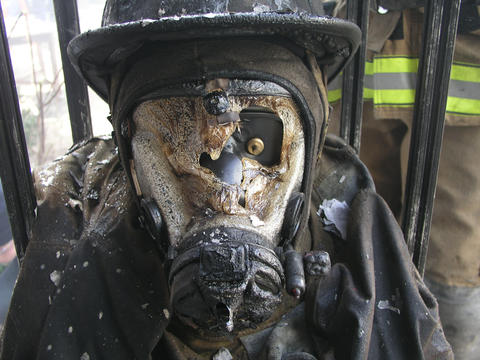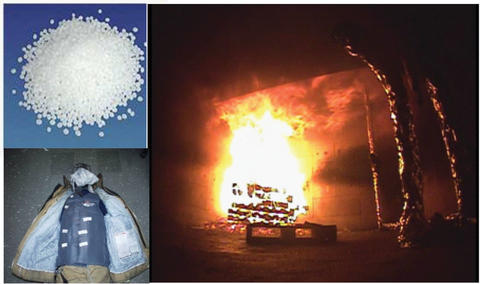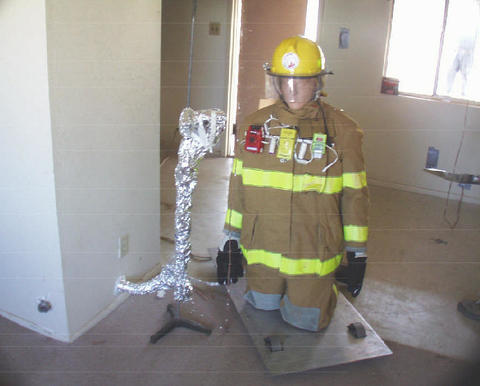Personal Protective Equipment
EMERGENCY FIRST RESPONDER RESPIRATOR THERMAL CHARACTERISTICS: WORKSHOP PROCEEDINGS

A diverse group of experts in SCBA manufacturing, certification testing, use, and research was assembled to discuss and identify needs and research priorities related to emergency responder respirators. The first goal of the workshop was to review the current state-of-the-art of SCBA technology and identify critical performance needs.
A summary of the performance needs defined by the workshop includes:
- Thermal resistance of the facepiece equal to or better than the rest of the fire fighter ensemble
- Understanding of and ability to sense the variable fire environment
- Responsible fire fighting culture, behavior and usage of SCBA.
After the performance needs were discussed, four areas were identified as priorities for further research and effort. The group presented both short and long term thrusts for each research area, including to:
- Improve SCBA facepiece design
- Characterize the fire environment
- Develop more representative and realistic testing
- Define best practices for use and behavior, and implement into training.
REPORT
Emergency First Responder Respirator Thermal Characteristics: Workshop Proceedings (NIST SP 1123, June 2011)
SELF-CONTAINED BREATHING APPARATUS
Fire fighters are exposed to highly variable environments including elevated temperatures and convective and radiant thermal flux, which can put a significant burden on personal protective equipment. Thermally degraded and melted self-contained breathing apparatus (SCBA) facepieces have been identified as a contributing factor in certain fire fighter fatalities and injuries in the United States. The SCBA facepiece lens is often considered the weakest component of a fire fighter's ensemble in high heat conditions.

The next step is to identify the exposure limit just before thermal degradation occurs. Data on the limits of the equipment would be valuable information for the fire service to help prevent further injuries and fatalities related to SCBA equipment failure. These fire experiments revealed information on the approximate heat flux and temperature environment that will cause a facepiece lens to degrade, but future experiments will utilize a gas fired radiant panel exposure, which can provide a controlled and repeatable way to generate a uniform heat flux. The heat flux from a radiant panel can be controlled and varied from low heat flux, with intensity just above the flux of sunlight, to a high heat flux representing conditions at the onset of flashover. In future experiments more information on the progression of the degradation can be gathered by recording video of the facepiece lens during the exposure. In addition, the breathing effect can be further studied using a breathing machine to simulate both inhalation and exhalation.
REPORT
Fire Exposures of Fire Fighter Self-Contained Breathing Apparatus Facepiece Lenses (NIST TN 1724, November 2011)
TURNOUT GEAR
Fire fighters' protective clothing (pants and jacket) is a three-component ensemble intended to protect the fire fighter from radiant and thermal exposure, unexpected flashover conditions, and puncture and abrasion hazards while still maintaining an adequate level of dexterity and comfort. The performance requirements for the individual components (moisture barrier, thermal liner, and outer shell) and the ensemble are described in NFPA 1971, whereas the selection, care, and maintenance of the "turnout gear" is described in NFPA 1851. Considerable research has been devoted to the development and testing of turnout gear. However, little information is available as to how environmental stresses on the turnout gear during routine activities and storage deteriorate its performance and service life.

This research focuses on developing performance metrics and standard testing protocols for assessing the aging performance of fire fighter protective gear. Understanding the aging performance of in-service turnout gear gives the fire service community measurement protocols to use as a basis for defining a minimum performance regulation to provide fire fighters with adequate protection to perform their duty and for defining a performance regulation for retiring turnout gear from service. In addition to developing performance-based regulations, understanding the failure mechanisms allows the development of new and/or utilization of existing technologies that will improve and extend the performance life of turnout gear.
WHY IS THIS IMPORTANT?
Structural fire fighters' protective clothing is designed to protect its wearer from the thermal environments experienced during fire fighting. Fire fighters may receive serious burn injuries from each of these modes of heat transfer or a combination of them even though they are wearing protective clothing. In addition, fire fighters' protective clothing is often wet when it becomes heated by the fire fighting environment. Hot vapors and steam are generated inside protective clothing systems that also produce serious burn injuries. Fire fighters' protective clothing has definite physical limits associated with its ability to protect the wearer. These safe use limits are poorly understood and are not addressed in current fire service protective clothing standards.
The Fire Fighting Technology Group is studying these physical safe use limits for thermal performance of fire fighters' protective clothing, and it is developing new test apparatus and predictive tools that will provide insight into the causes of burn injuries. This effort is helping to develop a better understanding and define the safe use limits of fire service protective clothing. As a result, this research effort will assist in reducing the number of serious fire fighter injuries.
REPORTS
Thermal Measurements for Fire Fighters' Protective Clothing (December 2001) Estimates of Thermal Properties for Firefighters' Protective Clothing Materials (NIST IR 7282, December 2005)
PERSONAL ALERT SAFETY SYSTEM (PASS) DEVICES

Different PASS devices from various manufacturers. |
Annually, hundreds of firefighters in the United States become trapped in structure fires, often resulting in injury or death. Firefighters can be quickly overcome by the heat or smoke of a fire and may be unable to alert other fire ground personnel to their need for assistance. Personal Alert Safety System (PASS) devices are designed to signal for aid via an audible alarm. Typically, PASS devices sense movement or lack of movement and activate a 95-decibel alarm signal if the lack of motion exceeds a specific time period. The loud alarm signal alerts other personnel that a firefighter has become incapacitated and it helps to guide rescue personnel to the location of the incapacitated firefighter.
While the current NFPA Standard for PASS devices (1982) requires only a motion detector, some manufacturers are beginning to incorporate thermal exposure sensors into each PASS device. Some PASS devices are also being integrated into fire ground personnel accountability systems.

NIST's instrumented mannequin for full-scale tests. |
WHY IS THIS IMPORTANT?
Developing standards for better PASS devices is part of the Fire Fighting Technology Group's continuing mission to improve Fire Fighter safety through research. Advanced PASS device technology has the potential to greatly impact fireground operations by significantly reducing the risk of injury and/or death to Fire Fighters.
This research will assess the current state-of-the-art in PASS technology and will examine specific enhancements, which may include elimination of false alarms, improve accuracy, linking to Global Positioning Systems (GPS) and/or personnel tracking systems, and incorporating additional sensors, such as thermal sensors or toxic gas analyzers.
REPORTS
Performance of Thermal Exposure Sensors in Personal Alert Safety System (PASS) Devices (NIST IR 7294, December 2005) Thermal Environment for Electronic Equipment Used by First Responders (NIST IR 1474, December 2006)

